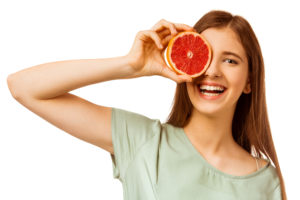Conjunctivitis: What is Pink Eye and How Can I Avoid It?
Conjunctivitis, or “Pink Eye” as it is more commonly known, is a common eye problem that can be treated relatively easily and avoided using a few simple precautions.
Pink eye is something anyone can develop, but it is seen more prominently among younger age groups where children are less cautious about exposure to germs. Students in schools of all levels are at an increased risk because of the increased levels of exposure to germs from other students, this makes it hard for teachers to avoid as well.
What is “Pink Eye?”
Pink eye occurs when the clear covering on the white of the eye—this is called conjunctiva—becomes inflamed. Despite being transparent, the conjunctiva actually contains blood vessels that overlay the sclera of the eye. When something causes inflammation in the eye the blood vessels in the conjunctiva dilate causing your eyes to become red and “bloodshot.”
Conjunctivitis can have several causes (see below), but many eye doctors use the term “pink eye” to refer only to viral conjunctivitis, a highly contagious infection caused by a variety of viruses.
Conjunctivitis can be caused by a multitude of different things, but there are precautions you can put in place to reduce your risk of having to deal with this irritating eye affliction:
- Avoid sharing items you wash your face with such as hand towels, washcloths, and tissues.
- Remember to cover your mouth and nose when coughing and/or sneezing and then make sure to not rub or touch your eyes.
- Never under any circumstances should you share your contact lenses with a friend.
- Don’t forget to wash your hands frequently, particularly if you are spending time at a public place where germs are more widespread.
- Always keep some hand sanitizer handy and use it when you don’t have access to soap and water.
- Clean surfaces that regularly are exposed to a lot of bacteria such as bathroom vanities, sink handles, phones, and kitchen countertops with the proper antiseptic cleaner.
- Be wary of your allergies. Pollen can cause your eyes to become very irritated and can bring on symptoms of conjunctivitis. Ask your doctor what you can do to reduce your allergy symptoms.
- If you are a contact wearer it is important that you follow your eye doctor’s instructions to the letter in regards to lens care and placement. Make sure to use contact lens solution regularly for your re-usable lenses or consider switching to daily disposables.
- Always wear goggles while swimming to protect your eyes from bacteria and other microorganisms that reside in the water, these have been known to cause conjunctivitis.
- Before bathing yourself always be sure to remove your contact lenses so that bacteria doesn’t get trapped between your eyes and the contact lenses.
If you believe you might be developing a case of Pink Eye, make sure to call your Eye Doctor so that the proper treatment can be prescribed.

Everyone has heard that they should be eating more carrots to improve their eyesight. This is because of the high levels of beta-carotene that is found in carrots which is said to be essential in maintaining healthy eyes. There are actually quite a few different vitamins and nutrients that are considered to be good for your eye health.
Here are 5 other vitamins and nutrients that you should consider adding to your daily intake:
Zeaxanthin and Lutein: These are considered to be important nutrients for your eye health and can be easily added to your diet through the addition of leafy green vegetables and eggs. Quite a few studies have been done that point to a diet with ample lutein and zeaxanthin reducing your risks of developing chronic eye disease, such as age-related macular degeneration and cataracts.
Vitamin C: Found primarily in fruits and vegetables, Vitamin C is an antioxidant. Studies suggest that vitamin C can lower your risk of developing cataracts and taken in conjunction with other vitamins and nutrients it is said to slow the progression of age-related macular degeneration.
Vitamin E: Considered to be a strong antioxidant, vitamin is found in high concentrations in nuts and sweet potatoes. Studies suggest that vitamin E helps to protect cells in your eyes from free radicals that can cause damage to your eyes fragile tissue.
Essential Fatty Acids: These are fats that are considered to be an important part of our diets. These fats are said to fuel our cells, boost our immune system and even maintain our nervous system. Studies show that omega-3 fatty acids are also considered to be important in maintaining proper eye health and retinal function. Fatty such, such as salmon are great sources of omega-3 fatty acids.
Zinc: This mineral is considered to play an essential role in transferring vitamin A from our liver to our retinas, which produces melanin—a pigment that helps to protect our eyes. Zinc concentrates heavily in our eyes, but predominantly in the retina. Studies suggest that ensuring you are receiving ample amounts of zinc in your daily diet will help to protect the inner workings of your eye.

There are a lot of myths and misconceptions about our eyes. I’m sure you’ve heard of the old myth where if someone hits you in the back of the head while you are crossing your eyes they will get stuck. Well, that is just one of the many silly myths that have come up over the years. The American Academy of Ophthalmology publishes a list of these myths on their website, but here is our “Top 4 Myths About Your Eyes.”
- “Reading in dim light can damage your eyes” – Reading in a dim light will most likely cause you to strain your eyes, which creates discomfort, but it doesn’t necessarily cause harm to your eyes.
- “Children can outgrow having crossed eyes” – If left untreated, young children that suffer from strabismus, or “crossed eyes,” can develop poor vision in one eye. Many of those who suffer from strabismus will require the use of surgery, eyeglasses, patches, or a combination of all of them to correct their vision.
- “Wearing corrective lenses or contacts will make you dependent on them” – This myth can be dangerous because children who suffer from high refractive errors require corrective lenses or they run the risk of never developing normal vision. If contacts are worn over extended periods of time without being taken out, it can cause damage to the cornea and increase your risk of eye infection.
- “Being visually impaired can cause learning disabilities” – While it is true that learning disabilities are generally caused by how the brain processes what it sees, they are not related to vision problems. Attention-Deficit Disorder (ADD) and Attention-Deficit Hyperactivity Disorder (ADHD) are two learning disabilities that influence your concentration which affects your ability to learn. Children who have vision problems do have a difficult time learning because they can’t see what is on the board, or read their school books.
It is important to know what is truth and what is myth, because some of these myths can do more harm than good. If you ever have any questions about these eye myths, it is best to see your eye doctor.

Most people try to eat healthy and take their daily vitamins, but it is easy to forget and cut corners when you’ve had a busy week. It is easy to take our eyes for granted, but they are the second most physiologically active part of our bodies—second only to the brain! This means our eyes required approximately 25% of the nutrients we take in daily to remain healthy. With this blog, we are going to talk about some easy things that can be done to your daily diet to help boost your eyes nutrition.
Here are four quick nutritional fixes that can help to maintain your eye health:
Quick Fix #1: Beans and/or brown rice make a great side dish
Beans and brown rice can complement almost any meal and they are also both fantastic sources of Zinc! Zinc helps to improve your bodies absorption of Vitamin A as well as aids in antioxidant enzyme functions. Zinc is said to help to protect your eyes from developing macular degeneration and night blindness.
Other sources: Shellfish, Cashews, Beef and Spinach
Quick Fix #2: Add some Flaxseed to your smoothies
Who doesn’t love a delicious and nutritious smoothie? Now, time to take that tasty smoothie to the next level! Add in some flaxseed! Not only will this add more depth to the flavor, but it will provide high levels of Omega-3 fatty acids which is said to help maintain a healthy retina.
Other sources: Walnuts, Halibut, Soy and Salmon
Quick Fix #3: Strawberries for dessert
Despite can actually play an important role in your nutrition if you are eating the right things. Strawberries are delicious and sweet, but also provides more Vitamin C than Oranges per serving! Increasing your Vitamin C intake can help to reduce your risks of developing cataracts.
Other sources: Oranges, Kiwis and Sweet Red peppers
Quick Fix #4: Snack on some almonds
Hey! Whoever said snacking is a bad thing? Instead of grabbing that bag of potato chips, grab a handful of delicious almonds! Just a handful of almonds contains enough Vitamin E to fulfill your daily nutritional requirements. Vitamin E plays an important role in helping to maintain your eyes lubrication, which keeps the surface of your eyes refreshed.
Other sources: Vegetable Oil, Pine Nuts, Sunflower Seeds and Tomatoes

Pretty much everyone uses computers or digital devices for something today. We are constantly exposed to digital screens either at work or in our personal lives and this constant exposure can lead to some eye strain over time. Not a lot of people are familiar with the issues of digital eye strain, even though they could be suffering from it on a daily basis.
According to the 2016 Digital Eye Strain report from the Vision Council 10,000 Americans were surveyed about their eyes and 65% of those Americans suffered from one or more symptoms of digital eye strain. Symptoms of digital eye strain typically include: dry or irritated eyes, blurred vision, eye fatigue and headaches.
So what is Digital Eye Strain?
Well “digital eye strain” can encompass a lot of different symptoms, but ultimately it is the discomfort you start to feel after using digital devices for extended periods of time. There are some simple things that can be done to help protect your eyes from digital eye strain due to daily exposure to digital devices, such as:
Avoid glare on your digital devices screen – Glare can make it difficult to view content on your digital devices screen, which can result in you straining your eyes to see. This will inevitably lead to digital eye strain if left unresolved, luckily you can purchase anti-glare filters for most digital devices.
Don’t forget to blink – This is in fact possible, studies suggest that we blink 66% less often when using a digital device. Blinking is essential in maintaining the health of the surface of your eye and in maintaining clear vision.
Utilize the 20-20-20 rule – It’s easy to lose track of when people using digital devices, but it is important to remember to take short breaks intermittently throughout digital device usage. The 20-20-20 rule suggests that for every 20 minutes you use a digital device, you should spend 20 seconds looking at something that is at least 20 feet away. This purpose of doing this is to refresh your eyes and give them a chance to readjust.

Research conducted by scientists studying infants with the Zika virus in Brazil have discovered new dangerous eye complications that can be linked to the virus. These eye complications can lead to possible severe vision loss and even possibly complete vision loss. Three Brazilian infants that have microcephaly—a birth defect caused by Zika that causes shrunken heads and brains in newborns—have been observed of also having hemorrhaging, abnormal blood vessel development and retinal lesions. This has never been observed before by researchers.
Close to 1.5 million people have been diagnosed with the Zika virus thus far in Brazil, a staggering figure, and 4,000 infants have been born with microcephaly. Due to the staggering number of people infected with Zika, the World Health Organization (WHO) has declared a public health emergency. A previous study on 29 babies in Brazil that had Zika induced microcephaly displayed evidence that one-third of those infected would develop eye problems of some nature.
Here are 3 eye related complications that researchers believe can be caused by the Zika virus:
- Hemorrhagic retinopathy – a condition in which the retina, the light sensitive area at the back of your eye, begins to bleed.
- Abnormal vasculature in the retina – A condition in which your eye is missing important blood vessels in the retina.
- Torpedo maculopathy – Appropriately named after the torpedo-shaped lesions that form in the macula—the central part of the retina—of the eye.

Do you like to spend a lot of time outdoors? Spending time in the sun, camping, hiking—these are all things that are great outdoors activities, but it is important to make sure you are taking the right steps to protecting yourself from the sun’s rays. Most people know to protect their skin from the sun, but the dangers the suns ultraviolent (UV) rays pose to your eyes are much less common knowledge.
In light of this, we wanted to take the time to share some information with you regarding UV eye safety and how you can better protect your vision when spending a lot of time outdoors. Here are five things people can do to cut their risk of eye damage from the sun:
- Choose the right pair of sunglasses – Not all sunglasses provide the same coverage and contrary to popular belief, the darkness of the lens does not determine if the lens blocks UV rays. Only sunglasses labeled as having “100% UV Protection” or “UV400” will protect your eyes from the sun’s harmful UV rays. Even if the weather is overcast you should still wear sunglasses as the suns UV rays still pass through cloud cover and can damage your eyes.
- Don’t look directly at the sun – I think this should probably go without saying but “DON’T STARE AT THE SUN!” Yes, this can be very damaging for your eyes and can even lead to irreversible damage in certain rare cases. Staring directly at the sun can cause holes to burn in your retina—this condition Is called “solar retinopathy.”
- Read the labels on your medication – According to a recent survey, one in three adults use medications that can potentially make your eyes more susceptible to UV damage. Some of the common medications that can cause these problems include: Birth control, psoriasis treatments, antibiotics and estrogen pills. If your medication increases your eyes susceptibility to UV damage, then it will be labeled as “causing photosensitivity.” If you see this one the label, make sure to protect your eyes and skin from too much sun exposure.
- Wear more hats – Sunglasses are a necessary investment for your fun in the sun, but you shouldn’t underestimate the effectiveness of a hat in regards to blocking sunlight. A combination of both is the best way to ensure your eyes are getting the protection they need from the sun’s harmful UV rays.
- Drive with UV protection – Studies have shown that car side windows on average only block 71 percent of UV rays, in contrast to the front windshield which blocks 96 percent on average. According to studies, only approximately 14 percent of car side windows provide high enough levels of UV protections to guard your eyes and skin from the sun.

A recent study was conducted that determined a large number of adults in America suffered from extreme nearsightedness (myopia)—9.6 million adults to be exact. Of that staggering number, 820,000 of those people suffer from degenerative eye disease and another 41,000 people deal with a serious vision complication which is called myopic choroidal neovascularization—which can cause permanent vision loss, women in particular seem to be more susceptible.
Over the past few decades’ nearsightedness has become increasingly more common. In fact, 30 years ago the percent of people who were nearsighted in the country was 25% and after the new millennium this number shot up to around 40%. Nearsightedness, thankfully, can be corrected with the application of eyewear or even surgery, but severe cases of myopia can cause lasting complications with your vision.
Pathologic myopia, also known as “Progressive high myopia,” is a degenerative form of nearsightedness that causes lasting complications with your quality of vision. Pathologic myopia causes the retina at the back of your eye to become atrophied. Those who have pathologic myopia are at a higher risk of developing myopic choroidal neovascularization.
The study conducted by the American Academy of Ophthalmology and Genentech determined the following major statistics:
- 0.33% of adults (approximately 820,000) in America suffer from the degenerative eye condition, Pathologic myopia.
- Approximately 4% of all adults in America have severe myopia, which is defined as -6.0 D or worse in the right eye.
- 0.017% of adults (approximately 41,000) in America suffer from myopic choroidal neovascularization.
- Pathologic myopia appears in 0.42% of women in America compared to it being seen in only 0.25% of men. Myopic choroidal neovascularization also appears to be more prevalent in women as numbers suggest twice as many women deal with the issue than men. Women seem to be at a heightened risk of developing serious myopic complications.

It is that time of year again! Back-to-School! Millions of parents around the country are rushing to stores to buy all the newest school supplies and outfits. While you are going through your list of school supplies make sure to not skip your child’s eye health.
You can’t underestimate the importance of ensuring your children have healthy eyes and good vision during the course of their education. Having healthy vision is essential in ensuring academic success no matter what the age. Children are especially susceptible to vision problems during their education because they are still growing so it is important that parents remain vigilant about their eye health. If we can identify vision problems in your children earlier, then the damage can be minimalized.
To ensure your child’s vision stays healthy throughout the school year, the American Academy of Ophthalmology has these recommendations:
- Regular eye exams for your child – As mentioned earlier children’s eyes experience rapid changes due to their body still growing and maturing, this makes regular eye exams that much more important to detect these problems as early as possible before they have an effect on your child’s academic success.
- Make sure your child is wearing protective eyewear while playing sports – Injuries from outdoor activities like Sports are fairly common, but what is less known is that eye injuries from this activity happen pretty commonly. Some of these injuries can be serious and cause permanent damage to your child’s vision, so it is important that they are using the right protective eyewear for their outdoor activities.
- Know your families eye health history – Knowing your families eye health history is important because you can inform the eye doctor of the history when your child is undergoing an eye exam. This provides your eye doctor with a little insight and helps them know what to be on the lookout for as your child continues to grow. Common vision conditions include: nearsightedness, farsightedness and lazy eye. It is important these are cart early so as to minimize the damages.
- Be on the lookout for signals that there might be a problem with your child’s vision – It is important to be vigilant with detecting symptoms of vision problems. If your child starts to complain about issues involving recurring headaches, eyestrain and you notice he/she is squinting a lot when reading then it is time for a visit to the eye doctor. If your child’s grades also begin to suddenly drop that could also be caused by problems with their vision.
Cataracts occur when the eyes natural lens becomes clouded with clumped up proteins. These proteins block light as it enters your eye which causes your vision to become gradually more blurry and if left unchecked could result in complete loss of vision.
These clouded lenses negatively impact your quality of life by making it difficult to read or drive a car—particularly when you are driving at night—among many other things.
Cataracts for the most part develop very slowly, in the beginning of your cataract development you wont even be able to notice a difference in your vision, but over time your sight will get worse. Oddly, with cataracts there is a point where your vision will become much better, but this is very brief and then the quality of your sight will drop dramatically.
You will be able to counteract the negative effects cataracts have on your vision at first with proper lighting and strong eyeglasses, but eventually you will need to undergo cataract surgery to assure you don’t go blind and maintain a good quality of life. If not removed, the cataract will continue to grow larger and cloud more and more of your eyes natural lens.
When is a good time to call my eye doctor?
Well, the best way to catch cataracts early is to schedule your routine eye exams so your eye doctor can take a look and ensure your eyes are in tip top shape. If you notice a sudden dramatic slip in vision however you should consult your eye doctor immediately.
